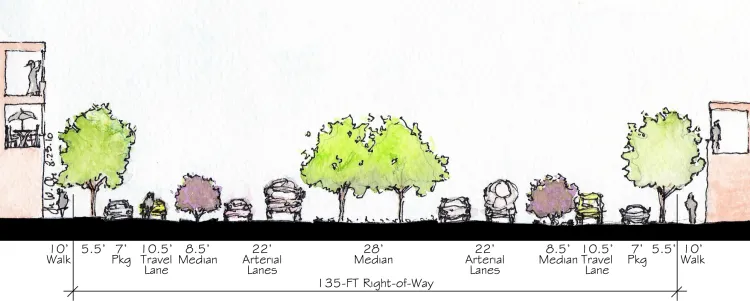There has been too much ado lately regarding safety sizing the streets in Colorado Springs — removing lanes from roads downtown to create bike lanes, slow traffic and decrease congestion.
Our city has been condemned to wasting money on infrastructure for decades — wrongly widening roads as we chase the White Rabbit to “solve congestion.”
The concept that widening roads or adding lanes will reduce congestion is wrong, and it’s been proven over and over again to be wrong.
The benefit of removing lane miles extends beyond financial costs of maintenance or safety to residents in and out of vehicles. Fortunately, the current city administration recognizes that it can flip a liability into an asset and transform the city’s health merely by downsizing its roads.
Locally, we have seen the results of successful road diets on Cheyenne Boulevard and Lake Avenue in southwest Colorado Springs. In Manitou Springs, they converted four lanes of travel to two lanes on Manitou Avenue, leaving a center turn lane. The road diets improved pedestrian and bicycle safety on all the streets.
Take New York City, for example. In 2007, former traffic commissioner Janette Sadik-Khan put the city on a road diet. For those who say you can’t compare New York City and Colorado Springs — you’re right. It’s much more difficult to remove lanes in New York City. So Sadik-Khan took a tactical approach to experiment with solutions.
She took Times Square — with its high number of vehicles and the greatest mass of pedestrians in the United States — and put it on a road diet.
Since 2006, just prior to the leadership of Sadik-Khan, New York City has added more than 250 miles of bicycle infrastructure and removed several lanes of congested roadway. It transformed the space for people, not just their automobiles. By adding alternative modes of transportation, all of which require less space, the localized economies adjacent to the roads benefit from having more people riding by on bikes, making it easier to make impulse purchases.
When she came into office in 2007, Times Square belonged to cars — although 82 percent of the people in Times Square were pedestrians. By 2009, NYC had modified 2½ acres of auto-dominated space, including Times Square, to pedestrian space. The Times Square transformation not only created safe, functional public space for the masses of New Yorkers and tourists, it also improved the flow of traffic. And, within one year, it doubled the real estate cost per square foot.
The sky is not falling when the city wants to change the number of lanes on a given street. In fact, a 2012 urban experiment, called Better Block Pikes Peak, by Colorado Springs Urban Intervention, showcased the benefits of removing traffic lanes and creating pedestrian space. With Better Block Pikes Peak, we aimed to illustrate with real-time data that we could improve the public space on Pikes Peak Avenue between Nevada Avenue and Tejon Street by transforming two excess lanes to a pedestrian oasis.
Fast-forward to today, and the thirst for rethinking our public space is as great as it ever was. The city is considering lowering the number of lanes on downtown’s Cascade, Nevada and Wahsatch avenues, along with Weber and Fontanero streets. The changes to Cascade Avenue recently went to the City Planning Commission to narrow the lanes on a short stretch through Colorado College. The plan for Cascade is to reconfigure the street from a four-lane street to a two-lane street with new bike lanes.
Traffic projections support the transformation — which should have been enough justification for approval. The traffic-engineering world is one that is incredibly conservative, therefore when you have a green light from the city’s traffic engineer, you should proceed as quickly as possible.
In her book Street Fight, Sadik-Khan wrote, “Why would a city be proud not to attempt something that has been so successful elsewhere?” It’s a question that we should ask about many things, but something such as this — where converting it is only a matter of changing the paint — what are we waiting for?
Originally posted on July 15, 2016 in the Colorado Springs Business Journal (http://www.csbj.com/2016/07/15/colorado-springs-needs-road-diet/)


Agree totally. We should also be looking at light rail to Denver rather than just expanding I-25 north of the Springs.
Absolutely. Wrote this one a couple weeks ago: http://www.csbj.com/2017/01/27/expanding-25-isnt-congestion-solution/